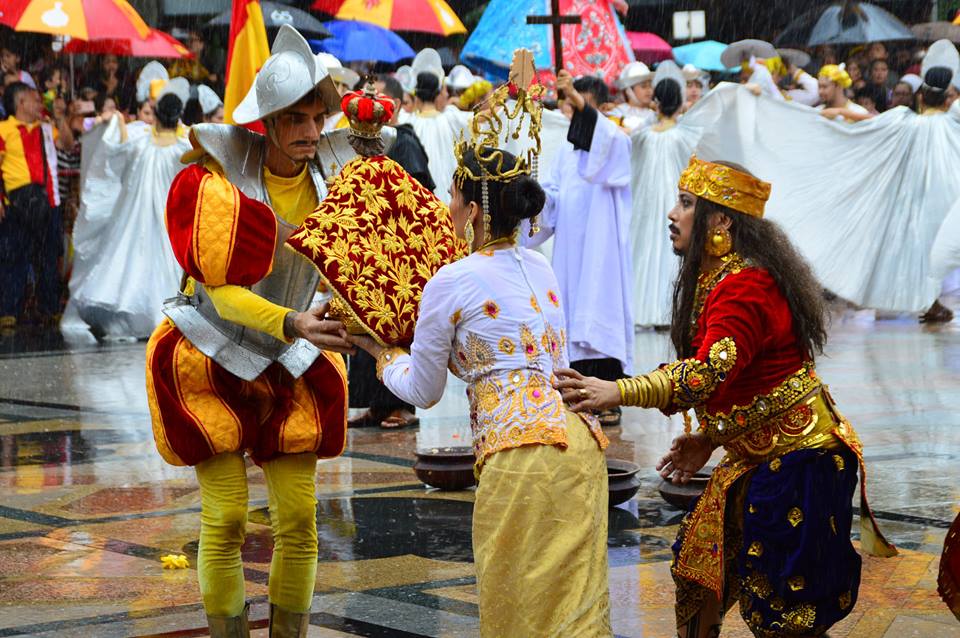 More than a million devotees brave rain to join festival honoring Child Jesus in the streets of Cebu City. One of the festival’s highlights is the reenactment of the giving of the Santo Niño de Cebu, by explorer Ferdinand Magellan to Rajah Humabon and his wife when he landed on the island in 1521. The two-day “Sinulog” or dance prayer celebration was held on January 14 and 15. (Photo by Lawrence Vidanes)
More than a million devotees brave rain to join festival honoring Child Jesus in the streets of Cebu City. One of the festival’s highlights is the reenactment of the giving of the Santo Niño de Cebu, by explorer Ferdinand Magellan to Rajah Humabon and his wife when he landed on the island in 1521. The two-day “Sinulog” or dance prayer celebration was held on January 14 and 15. (Photo by Lawrence Vidanes)
500 Years of Christianity (Part 4)
Beautiful religious traditions and customs evolved over 500 years. Some are gone, some are disappearing, and some still evolving.
A: Gone
- Latin Mass.
- 6 PM church bells ring for Angelus. Everyone near the church stop moving until prayers are finished, even cars, caretelas, etc.
- Women in modest dresses (no shorts for adults)
- Holy Week. Businesses, stores close, no music/radio, closed movie houses, no noise, physical activities in the house starting Thursday to Saturday.
B: Disappearing slowly
- Blessed Palms nailed on house front door
- Veil when in church, scapulars around waist or neck
- Dip right hand in the fountain before and after leaving church
- During Mass, people kneel and stand when asked
- Running out after Mass before the priest leaves the altar (car parking)
- Obedience. Despite request before mass, some keep open cellphone, then run outside or worse during homily, play with cellphone, seated cross legged, (all signs that the evil one is tempting us even during masses)
- Benediction of priests and elders by kissing hand or putting hand on forehead.
- Parish fiesta carnival, ferris wheel, tsubibo, merry-go-round, juego de annillo (bicycle rider putting a needle on a ring hanging on a ribbon), palo sebo (climbing greased pole with sack of cash on top of pole, pabitin (kids jump to grab bags of candies hanging on big square bamboo platforms moving up and down), fireworks, caros/floats, nightly programs during novena and procession on fiesta day, Flores de Mayo Santa Cruzan with afternoon children catechism classes, merienda, procession on katapusan with live band, sagalas with women (there are those who say it is irreverent to Santa Maria and Santa Elena, the main figures in the May time activity by modern sexual standards)
- Christmas carol. Today you cannot see bands, rondallas, group caroling. 2 or 3 children carol and stop after two (2) incomplete, foreign songs like Joy to the world, bercive, bercive ber king, emercy mercy my, emercy mercy my, in heaven denature sing, in heaven denature sing xxx. These children keep the Christmas joy and spirit alive in spite all the earthly gadgets, gimmicks, greed, and walang paki.
Very special, old, and only in the Philippines traditions
- The January Quiapo Black Nazarene procession has the world’s biggest devotee participants (at least 2 million) walking in the world’s longest city / urban panata / vow which starts at 5 AM and reaches Quiapo church at 12:30 PM with more devotees praying along the route
- The Sto. Niño fiesta on the 3rd Sunday of January called Ati-atihan in Kalibo, Aklan, Sinulog in Cebu, Pista in Tondo and Dinagyang in lloilo City which is celebrated on the 4th Sunday of January. Ati-atihan is colorful, lively, and the original Sto. Niño fiesta. Sinulog has Asia’s biggest Catholic fluvial (sea) parade and the crowd is as big as the Black Nazarene procession. The Tondo Pista is simple but the zeal and dedication of the devotees must be seen.
- Christmas. The Philippines has the longest season in the world. By September, we hear Christmas songs on radio. We remove all Christmas decoration only on January 6 (Feast of the Three Kings). We Invented, re-invented and improved Diana (a band goes around the city in a bus playing lively music at 4 AM to wake the faithful so they attend the Misa de Gallo from December 16-24)
- Misa de Gallo mass is not done in other places. By December, America and Europe is knee deep in snow and it is very, very cold on other parts of the world. Beside the church after the Misa de Gallo mass you can drink salabat, sikwate, eat puto bumbong, bibingka, suman, etc.
New traditions
The Wednesday Mother of Perpetual Help novena is the most popular nationwide. Celebrated first in 1946 in Iloilo’s St. Clement’s Church, it was brought to Baclaran in 1948. Baclaran has Asia’s biggest number of Mother of Perpetual Help devotees.


No Comments